Brighouse Cricket Club History
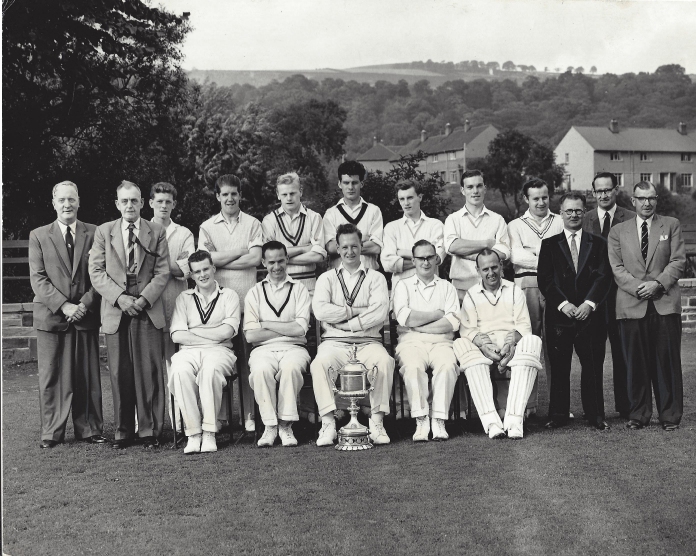
The early days
The club was founded in 1873 by the amalgamation of Alexandra Cricket Club, who played behind the parish church and the Working Men’s Club. A new ground was developed and laid out at Clifton Road, Brighouse and was given the name of the New Alexandra Cricket Ground. The first match saw Brighouse beat Clifton by two runs on May 30, 1873 and the gate receipts were just over £3.
The club started to hold athletic festivals and these became very famous in the local areas. At the very first event the records show that a W. Clark won the “Throwing the cricket Ball’’ with a throw of 86feet 6inches.
In 1876 W Shotton was signed from the Huddersfield club Lascelles Hall as their first professional. His association with Brighouse proved to be long and successful. He played 12 seasons for the club as both professional and amateur, scoring 3,011 runs and taking 318 wickets. He had played two matches for Yorkshire CC.
Derby matches with Rastrick were always keenly fought affairs, especially in the 1870s. By 1876 they played each other and the first Brighouse victory came in 1878 with Luke Greenwood, from Lascelles Hall, engaged as professional. Greenwood was one of the great pioneers of early Yorkshire cricket. He was a regular in the county side from 1861 until 1875. In the Brighouse victory over neighbours Rastrick he scored 39 not out and took 5 wickets.
New pavilion
In the years of 1884 and 1885 the club raised sufficient funds to build the pavilion that was still in use until 2002. In the same year the club had three matches cancelled because of “A raging smallpox epidemic in Brighouse and surrounding district”.
By the late-1870s the club, which now went under the name Brighouse Alexandra, was becoming more established in local cricket circles.
This was clear from its expanding fixture list, which included matches against more prestigious opponents. One of the leading clubs in the North was Todmorden who were approached in 1878 to arrange two 1st XI fixtures and one 2nd XI match for the following season.
In 1893, Brighouse became founder members of the West Riding League, which was recognised by the Athletic News as ‘the chief organisation of its kind in the county’.
The competition was an attempt to form a regional cricket league along the lines of the Football League and the later Northern Rugby Football Union. It included Leeds, Huddersfield, Bradford, Sheffield United, Dewsbury, Keighley, Barnsley, Brighouse and Halifax.
In fact, it went further than the initial rules of the Northern Union by allowing open professionalism to exist alongside payments for ‘broken time’. Two professionals were allowed per team, and the rules also decreed that: ‘An amateur shall be defined as one who does not receive any money over and above expenses actually out of pocket and an exact equivalent for the loss of his wages accruing from his usual occupation.’
By 1899 the West Riding League had folded as the financial demands of semi-professional cricket on this scale were not met by public interest.
First major trophies
The club’s first major successes in both league and cup competitions came in 1918 when the Yorkshire Council Championship and the Halifax Parish Cup were both won. This was a remarkable achievement and really put Brighouse on the cricket map.
Records from 1908 show even more development as a large extension was added to the pavilion enabling the installation of two billiard tables and also a concert room and “two slipper baths upstairs”. In 1914 a new workshop competition attracted 64 teams. Its popularity has continued across the years and the competition remains in existence today.
County players at Brighouse
During the First World War the club competed in the Halifax Section of the Yorkshire Council and engaged players of the calibre of George Hirst, Wilfred Rhodes and Alonzo Drake.
All of them played for Yorkshire while Hirst and Rhodes were also capped by England.
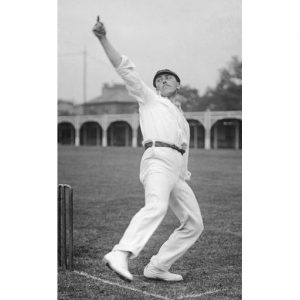
Into the Bradford League
It 1925 Brighouse joined the Bradford League. The first fixture on April 18th 1925 was a home clash against Great Horton. The new boys went on to finish a very respectable ninth with George Lund setting a new league record aggregate of 954 runs.
In July 1927 the scorebox was officially opened by J.J. Booth who was president of the Bradford League. Yorkshire batsman Wilf Barber made his mark in 1927 by topping the League Batting averages with 53.15.
Brighouse were desperately unlucky not to land their first silverware in 1928 when Bradford beat them in a play-off for the championship.

Wilf Barber is a cut above
Barber scored a total of 16,402 First Class runs in his career with 29 hundreds and 182 catches, and was recognised as “the fourth pillar” of the Yorkshire batting in the mid-1930s (after Herbert Sutcliffe, Maurice Leyland, and Arthur Mitchell. Barber’s highest score was 255 against Surrey in 1935. In this innings, he opened the batting and shared three successive century partnerships.
Barber also scored 248 against Kent in 1934. He had scored 73 in the first innings but Kent had built up a lead of 148 on the second day of the match. Barber, opening the batting with Len Hutton, scored 248 and shared a stand of 267 for the first wicket. As a result, Yorkshire drew the game.
Barber shared in seven other century opening partnerships Yorkshire, four of them with Arthur Mitchell, and six other 200 partnerships. This included a stand of 346 in four and half hours with Maurice Leyland, against Middlesex in 1932 which was a record for Yorkshire’s second wicket.
The league title finally found its way to Brighouse in 1930 when they emerged top of the pile in a thrilling battle. In a tense ending they finished a point ahead of both East Bierley and Bowling Old Lane. It was the start of the most successful spell in Brighouse’s history as they won the title again in 1931 and 1932 to complete a well deserved hat-trick.
One of the catalysts for their success was Jack Hill snr who was a remarkably consistent batsman. He topped the League Batting averages in 1930 and 1932 and was second in 1931. Hill’s averages of 52.28 and 43.07 in 1930 and 1931 respectively, were overshadowed by his average of 99.11 in 1932. His tally of 892 runs included one century and nine fifties.
Another influential player of 1932 was J.Crossley of Brighouse who scored the league’s top score that year- 167* v Baildon Green.
Trophies proving elusive
Although trophies proved elusive for the next 30 years it was not without credible achievement in the rest of the thirties decade when they finished in second place in both 1935 and 1937.
Brighouse possessed some powerful batsmen in M T Wade, H Hutchinson and GG Gill.
Wade averaged 51.00 in 1933 with a top score of 142 not out to finish second in the league batting averages. He would beat this in 1937 finishing top with a lesser average of 46.40.
H Hutchinson topped the league averages in 1936 with 804 runs at 53.60, and in the following season scored centuries against Eccleshill and Farsley.
At the dawn of the 40’s Wilf Barber finished second in the league batting averages in 1940 with a haul of 954 runs at 59.62 and a top score of 154.
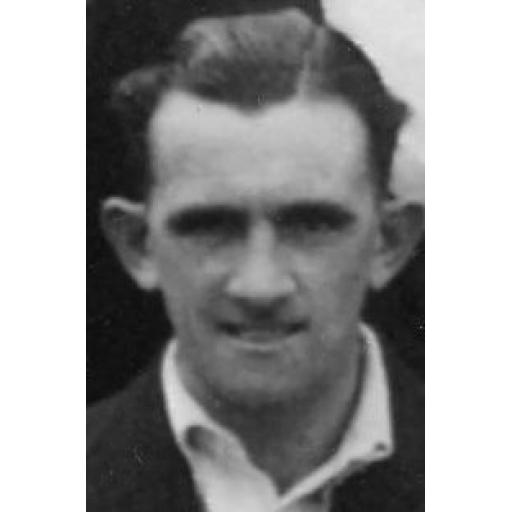
Another First Class cricketer in the ranks was Alex Coxon who excelled for Brighouse in 1944 taking 51 wickets and scoring 423 runs. He was 28 year old and poised to make his Yorkshire debut at a mature age.
Coxon who was born in Huddersfield had a World War II delayed first-class debut for Yorkshire in 1945, when he was 29. He was an aggressive fast-medium bowler who only ever made the verge of the England Test squad. He played for England once – against Australia in 1948 at Lord’s. There were rumours of an argument with Denis Compton and his prickly nature was later attested to by Brian Close..
Coxon retired after the 1950 season, allegedly in umbrage at his non-selection for the forthcoming Ashes tour, and moved to play MInor Counties cricket with Durham. He played 29 times for that county between 1951 and 1954, taking 127 wickets and scoring 1,047 runs with two centuries. His highest score was 102 not out against Yorkshire Second XI att Scarborough in 1952. Also in 1952, he achieved his best bowling figures for Durham; nine for 28 and six for 58 against Staffordshire.
It is incredible for a club of Brighouse’s standing that they have only one Priestley Cup Final appearance on their record and that was in 1943 against Pudsey St Lawrence. On the day they proved no match for Pudsey St Lawrence who batting first scored 149 before bowling Brighouse out for 65.
Post-War blues
After the war Brighouse found themselves in the doldrums and performing in the second division. Only the consistency of bowler R Swindall sustained them as they struggled to make an impact.
It got even worse in 1952 when they were asked to seek re-election from the bottom position, but incredibly they won the Division Two title in 1953, eight years after being relegated from the top flight. They were not straightforward champions as their points and wins record was identical to Undercliffe at the top. Only a complicated run and bowling aggregate method could separate them in Brighouse’s favour.
The influential batters were W.Bottomley (569 runs), W.A. Shackleton (311 runs) and G.Hirst (370 runs), while S.Norton took the honours with the ball taking 39 wickets.
The emerging Ken Taylor
Also in 1953, an 18 year old Ken Taylor, a future Yorkshire player, had a brilliant run with the bat. By mid-July he was averaging 355 from six innings.
After a decent consolidation season iby the 1954 team, above, they pushed the boat out the following season acquiring the services of Ken Taylor for a second season and Peter Marner. However, this led to them only moving up a couple of places in the table.
Ken Taylor scored the league’s biggest innings of the season in 1954 with 145 v Baildon. To demonstrate his all round abilities he also had a return of 7-54 that season against Yeadon.

Taylor was an important member of the successful Yorkshire team which dominated the county game winning seven titles between 1959 and 1968. Often an opening batsman, he was also an occasional bowler, taking 131 first-class wickets in his career. He was a member of the Yorkshire team that won the final of the third Gillette Cup 1965.
Taylor made his first appearance for Yorkshire in 1953, aged 17, won his county cap at 21 and played for England at 23, opening the batting against India with Arthur Milton. He was dropped after two matches, but was selected again in 1964, after an epic innings of 160 att Sheffield against the visiting Australians. He scored 13,053 First Class runs at 26.74 with a top score of 203*. He was one of the few virtuoso fielders of his genre.
Taylor was one of the last footballer/cricketers who could effectively divide their time between two sports. He made his name as a footballer with Huddersfield Town.
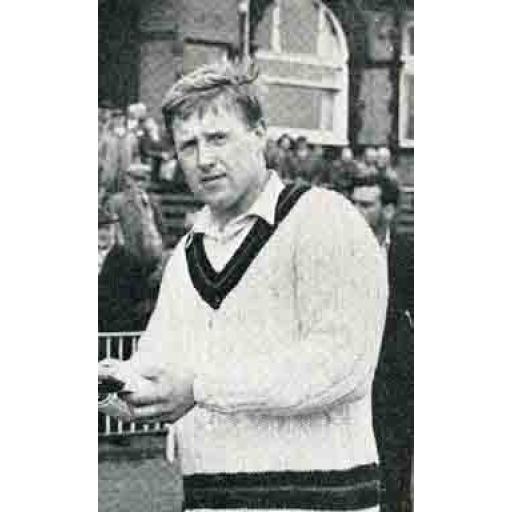
The 19-year- old Marner was on Lancashire’s books at the time having already made his First Team debut at 16 years 5 months. In 13 innings for Brighouse he scored 412 runs at a healthy 31.69 with a top score of 99.
Powerfully built, he was a hard-hitting right-handed middle-order batsman, right-arm medium-paced seam bowler and a specialist slip[ fielder. He was rated byy Trevor Bailey as the most formidable English batsman without a Test cap..
Marner is in the record books for being the first person to win a limited-overs Man of the Match award, when Lancashire played its first Gillette Cup match against Leicestershire at Old Trafford in May 1963. He scored the format’s maiden century in that game with an innings of 121, and also took three wickets for 49 runs.
He clashed with the authorities at Lancashire, and moved to Leicestershire after the 1964 season. He reached 1,000 first-class runs in 12 seasons, 17,513 career runs, scored 18 centuries, took 360 wickets, and held 379 catches.
Back in the second division Brighouse took the huge step in recruiting Yorkshire and England opener Frank Lowson for their promotion push in 1959. They were promoted, tied to the same points as Pudsey St Lawrence, with Lowson scoring 805 runs.
First title win
Brighouse’s fortunes were on the up again and the league title came their way in 1960 when they won the 1st Division Championship. This was all the more remarkable for it was their first season back in the big time. Lowson’s contribution to the title was massive scoring 746 runs at 46.63 with a top score of 116.
Frank Lowson’s influence
Although these batting figures appear modest compared to today one needs to appreciate that wickets in league cricket in 1960 were largely uncovered. Later In 1963 Lowson became the first Brighouse batsman to top the 1,000 run mark when he made 1,025.
Lowson’s elegant stroke play was obvious for all to see and he was a favourite autograph capture for cricket mad schoolboys in the area. Lowson played in seven Tests for England from 1951 to 1955. In first-class cricket, Lowson amassed 15,321 runs at an average of over 37, but had drifted away from the county game by his early thirties.
He came late to first-class cricket and was an instant success as an opening batsman for Yorkshire, scoring 1,799 runs in his first season, 1949, and partnering Len Hutton in the most prolific season of Hutton’s career.
The following year, 1950, Lowson was even more successful, scoring 2,152 and continuing a hugely productive partnership with Hutton.. The partnership moved into Test cricket against the South Africans in 1951. Lowson’s first Test innings was 58 out of a first-wicket partnership of 99 with Hutton at Headingley and he retained his place for the final match of the series a The Oval.
Lowson played in four of the five Tests againstt India, and made his highest Test score (68) in the first match. He scored more than 1,000 first-class runs on the tour, at an average of 44 runs per innings, but could average only 18 in the Tests. Wisden’s review of the tour said; “Lowson possessed more strokes and looked the most accomplished batsman on the side, but he had an unfortunate time in the Tests. His skill could not be denied and he seemed an England batsman all over, the only doubt being the question of temperament”.

The fallow years
The forty year sequence of 1964 to 2004- was relatively undistinguished at Brighouse. They had one Second Division title win in 1991 but kept up the tradition of not making much of an impression in the Priestley Cup. However, they had several individual performances that will stay in the annals of Bradford League history.
In 1966 left-hander John Dickinson scored a magnificent 137 v Saltaire to take the best individual league score award for that season. He would become one of the leading committee workers at Brighouse in subsequent decades.
Peter Brannan was an excellent wicket-keeper in the seventies taking the league prize for stoppers in 1976 and 1978,
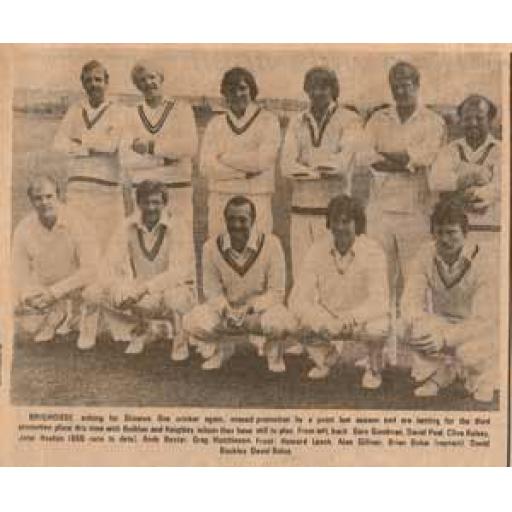
Batsman Allan Gilliver emerged in the late seventies and quickly became a modern Brighouse legend. He won the First Division Batting Averages for 1977 and 1978 which included 1,021 in the latter season. He forged a prolific opening partnership with John Heaton who also scored 1000-runs plus in 1980.
The 1991 2nd Division title winning side was built around the all round talents of M James who scored 994 runs, and also took 35 wickets. In a strong batting line-up that won most run chases the other leading batsmen were C Fisk (812 runs), H Jameson (425 runs), J Swaine (564 runs) and M Bray (438 runs).
This success was not sustained with immediate relegation in 1992 despite consistent batting from C Fisk (625 runs) and J Swaine (640 runs)
The Iqbal Khan years
During the nineties Brighouse dropped lucky with a wonderfully consistent overseas player in Pakistani Iqbal Khan. He guarded his wicket very carefully before unleashing a full range of shots. Incredibly he topped a thousand league runs for the season in 1993, 1994 and 1995.
Another overseas player in 1999 was fast bowler Faisal Afrdi who was less impressive as a batsman but did take the fastest fifty trophy reaching it in 20 balls.
Apart from Afridi’s exploits in 1999 left arm spinner David Jay had a magnificent time taking 74 wickets. Jay was a surprise signing for Brighouse after an illustrious career with East Bierley where he won most honours open to him.
For several years it had been mooted that Brighouse had struck up an agreement with Tesco to relocate elsewhere leaving their fine oval ground to be turned into a supermarket.
The pavilion was an authentic cricket pavilion, complete with Union Jack flying from the roof, a plethora of flowerpots, and an atmospheric beer garden. Inside there were two full-size snooker tables, notices about forthcoming events and a superb oil painting of the ground.
For first-team fixtures in times gone by, Brighouse attracted a decent crowd at their former ground, with VIPs and the more vocal elements sat in front of the dressing rooms, with children lying on the grassy verge to the left as one looks out from the pavilion, and elderly spectators sitting in their deckchairs or in their vehicles in the shade to the right.
Last season at Clifton Road
In their last season opposite the Ritz , there were definite signs of enterprise: the official programme (cost: £2), the ticket-sellers wandering the boundary’s edge trying to promote the Saturday-afternoon raffle, the four advertising hoardings near the bowling greens and the two large ads on the green-and-white scoreboard front for Tesco and Shabab, a local Indian restaurant.
During their last season at the old ground, the players changed and took tea in a set of portable buildings that were erected in March 2001. (The umpires had separate facilities nearby).
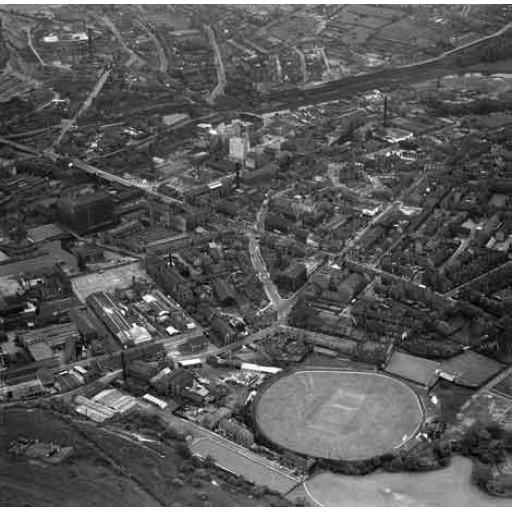
At Park Avenue
In 2002 while awaiting the finishing touches to their new ground they hired the famous Bradford Park Avenue ground for their home matches. Although they finished well down the second division they had some decent performers in Phil Carter who scored 701 runs, and David Jay who took 63 wickets.
In the second and final season at Park Avenue fortunes declined further on the field with 24 points being deducted for failing to fulfil two second team fixtures. Despite being in a lowly position there were some fine contributors with the bat in J Marchant (853 runs) and Carter (517 runs). Jay replicated his 2002 haul of 63 wickets.
Russell Way
In 2004 Brighouse moved to a magnificent new ground on Russell Way. Although many Bradford League followers lamented the passing of the character old ground with its unique oval shape, the new ground was built to Minor County specifications with facilities to match. The response on the playing side was swift as they won promotion back to Division 1 in 2005. Seamers James Stansfield (57 wkts) and Robin Hill (53 wkts) did the damage with the ball and were largely instrumental in this feat.
At this stage Brighouse had found the resources to have a real go at the top division with a team capable of going places. They consolidated into First Division cricket in 2006 helped enormously by Rizman Ahmed who topped the league batting averages with 823 runs and also contributed 50 wickets. Former Yorkshire Academy player Haroon Rashid was a useful capture scoring 617 runs.
Despite an array of expensive stars they struggled to make an impact in 2007. Top batsmen were Rashid (887 runs), Mark Gill (436 runs), Mark Gilliver (608 runs), while the cutting edge bowling was supplied by Chris Greenwood (52 wkts) and seamer Tim Linley (42 wkts). Linley would leave Brighouse at the end of the season to join Saltaire and ultimately establish himself at Surrey.
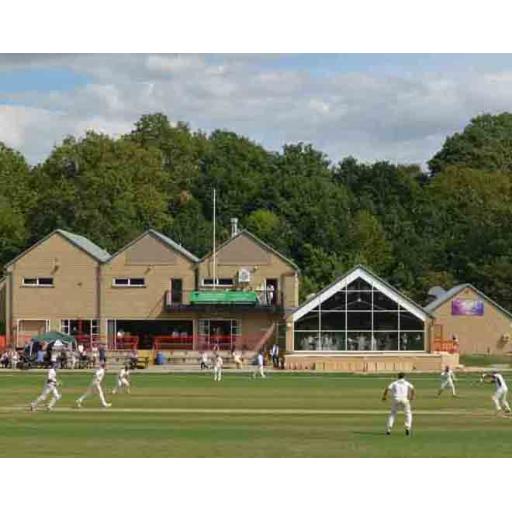
Fading fortunes
The playing budget was drastically cut for 2008 and the assorted stars from the previous year went their separate ways. An assortment of young rookies and second teamers took the field and there was to be only one fate awaiting them. They were stranded 139 points behind the next basement club in their relegation season.
The following season would see them bottom of the second division despite recruiting a very handy all-rounder in Paul Cummins, above. who scored 750 runs and took 41 wickets. He performed even better in 2010 taking the Jack Hill All Rounders Prize after scoring an impressive 1,052 runs, coupled with 52 wickets.
Cummins was the archetype sheet anchor opening batsman who would bat all day despite not scoring freely. His stroke play was limited but he was invaluable in a very limited Brighouse side. Sajad Ali was a good capture from Saltaire scoring 545 runs, and taking 36 wickets and helped his side avoid the re-election placings.
Brighouse returned to the bottom of the league in seasons 2011 and 2012 but made a decent revival in 2013 under the new leadership of former Lightcliffe player Umar Salim. He recruited well and kept his side comfortably away from the re-election area. Sadaqat Zaman was the pick of the bowlers with 41 wickets.
The revival failed to continue in 2014 when they were caught in the re-election placings seven points behind third bottom Spen Victoria. They ended the season well with a 20-point victory against Gomersal with Fakhar Hussain scoring a remarkable 168, and also taking 4 wickets for 41.
Hussain proved to be a shrewd overseas player and was the only Brighouse player to feature in the league averages as he strived hard to keep them afloat. His century against Gomersal took the honour of being the top individual score in the league for 2014. During this innings he also secured the League’s Fastest Fifty when he performed the feat in 16 balls.
Fortunes improved marginally in 2015 when Brighouse escaped the bottom two places, but not by a large margin. The best performer was Sohail Hussain who scored 590 runs at 45.38.
Any progress in 2015 was negated the following year when Brighouse just won two matches, finishing bottom of Championship B. The bowling lacked penetration and Wajid Hussain and Awaise Hussain were the only batters to top 300 league runs. The one highlight of the season was their victory over much fancied Methley.
Despite a nightmare first-half of the 2017 season which saw nine losses and two abandonments, things picked up dramatically. When Brighouse beat Liversedge on July 8th, it was one of four victories out of the next five matches that took them from the foot of the table. Results were mixed there afterwards, but their 11th position with six wins was an improvement on the previous year.
The club’s cause was helped enormously by Sohail Hussain and Asad Mahmood who both performed consistently well. Hussain scored 618 runs at 36.36, and also took 23 wickets. Mahmood, a steady medium pacer took 28 wickets at 16.11, and as a big hitting batsman struck 444 runs at 29.60.
On his day Mahmood could turn the game with the bat, and against promotion contenders Altofts he scored 141 runs from 108 balls, including 14 sixes and six fours.
After the demise of Idle CC, most of the players signed for Brighouse, giving them the strength in depth that had been previously lacking.
The key signing was overseas all-rounder Deron Greaves, who was hugely influential in turning their fortunes around. He won the league batting averages with 789 runs at 65.75, and also took 39 vital wickets.
By the half-way mark of the season the club was tucked in behind the top three and ready to pounce for a promotion place, They were playing good cricket and also making progress in the cup.
Things started to go awry when their semi-final place was taken away from them by the Board who discovered they had played an ineligible player. They had beaten Keighley, who were reinstated, in a one wicket thriller that had put the club on the map again.
Later, they were found to have played ineligible players in the league, and after a Board enquiry were docked 90-points and relegated to the Conference for 2019.
They ended the season playing good cricket and finished in 8th position despite the points deduction. Hussain continued his form from the previous years, scoring 599 runs at 46.08.
Player departures and little quality recruitment led to a disappointing 2019 as Brighouse effectively finished third bottom in 8th place. The four victories obtained were against teams around them at the bottom end of the table.
The only players with substantive success were Tanvir Bashir who was the leading run-getter with 372 runs, and Mohammad Altaf who took 31 wickets at a very competitive 12.71.
Brighouse took part in the Gordon Rigg Division Three League Cup competition when Covid-19 delayed the season.
They led the West Section from the start and seemed to be set for final day. However, they were stripped of the bulk of their points when it emerged that they were playing an unregistered player.
Loan player Sohail Hussain, and Parvaise Khan both excelled with bat and ball in the shortened season. Hussain won the Divisional Three bowling averages with 13 wickets for 4.15.
